Art Fairs
Despite China’s Wavering Economy, Western Dealers Find Plenty of Encouragement at Shanghai’s Art Fairs
Art021 and the West Bund Art Fair serve as complements to one another.
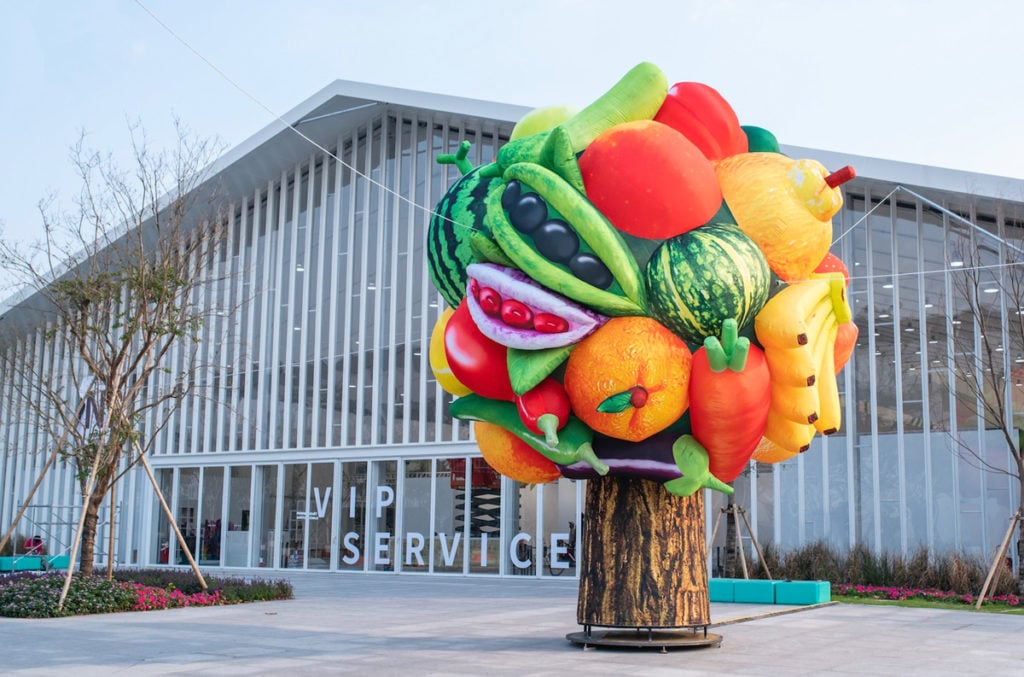
Art021 and the West Bund Art Fair serve as complements to one another.

Eileen Kinsella

The art world descended on Shanghai this week as the opening of two major art fairs coincided with the launch of the Shanghai Biennial. The convergence of big events makes the city a key stop on the global art circuit for Asian galleries and international mega-galleries alike—despite fears haunting the Chinese economy that include slowing growth, a weakening currency, a real estate bubble, high levels of debt, and a possible trade war with the US.
Art021, now in its sixth year, opened to VIPs at the Shanghai exhibition center on November 8, with roughly 103 exhibitors. Despite the looming warnings of an economic slowdown from China’s authorities, the crowds thronging the halls here seemed upbeat. Dealers reported brisk sales within hours. By the end of day, several said they were nearly or completely sold out.
Meanwhile, another fair held at West Bund, near the water and farther from the city center, was already on. The interior of the West Bund Art Fair, with its concrete floors and white walls, has a setup and aesthetic that would be familiar to visitors to the likes of the Armory Show or Frieze.
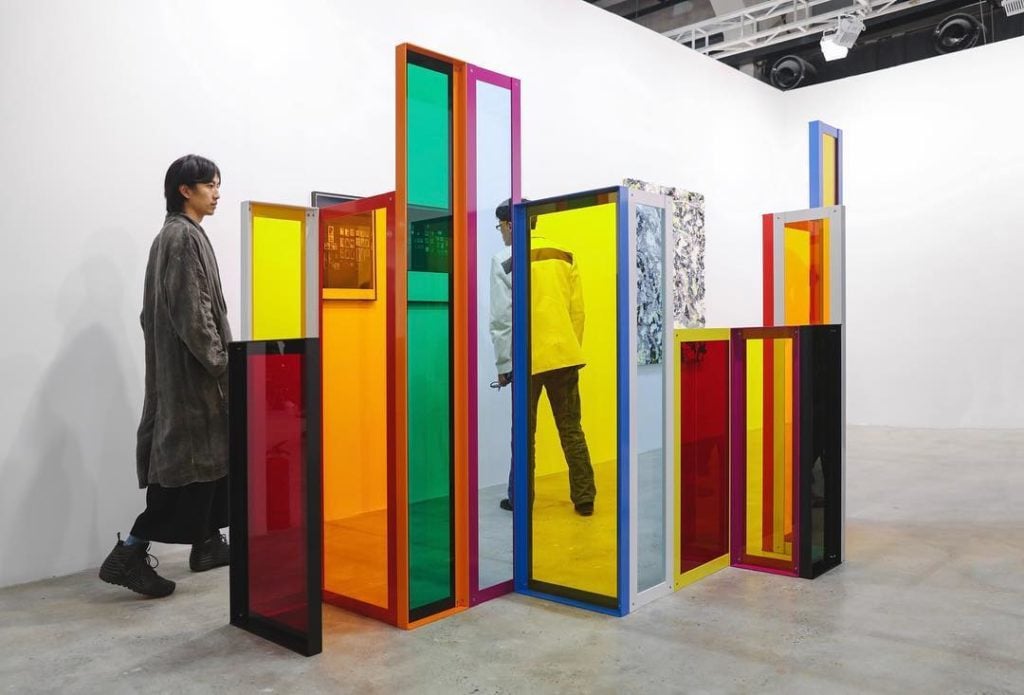
Visitors at Kerlin Gallery’s booth featuring work by Liam Gillick and Phillip Allen. Courtesy of West Bund Art + Design Fair.
The fairs feel very different. And yet numerous galleries, including powerhouse names like Gagosian, David Zwirner, Hauser & Wirth, and Emmanuel Perrotin, chose to exhibit at both.
“Each fair has a totally different dynamic,” dealer Thaddaeus Ropac, who also exhibited at both venues, told artnet News. “Art021 is more accessible, popular, and reaches a younger and more fashionable audience. West Bund is more art-world oriented and also more difficult to access geographically as it is not in the center of the city.”
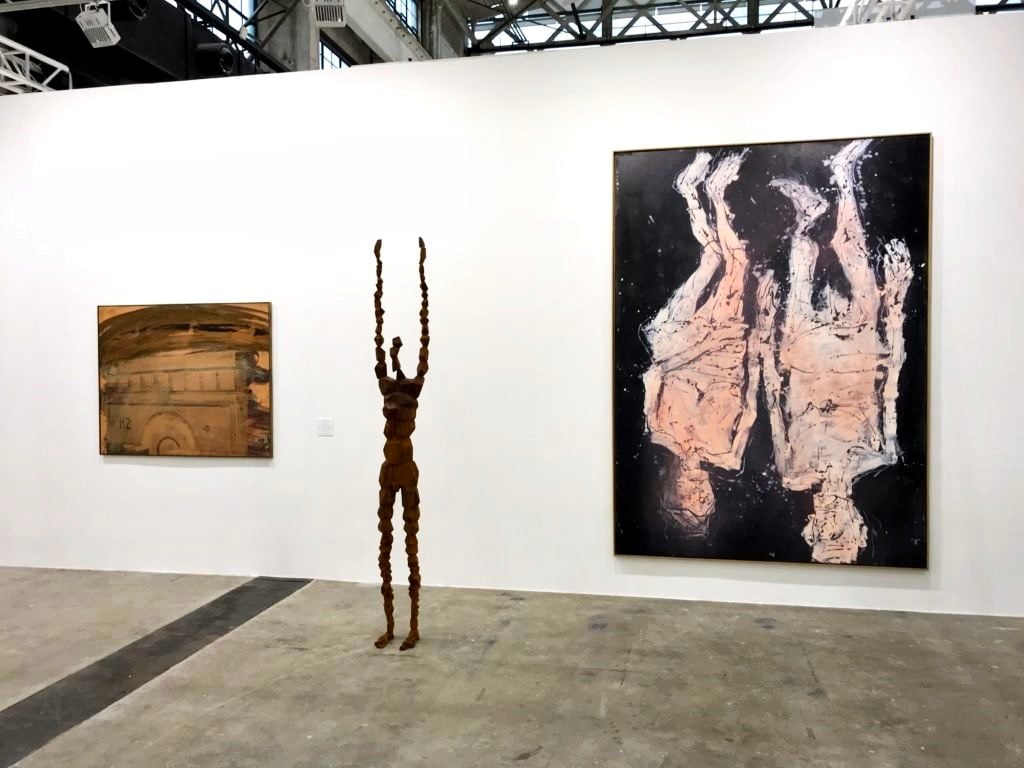
Installation view of Galerie Thaddaeus Ropac at WestBund 2018. Photo courtesy Galerie Thaddaeus Ropac: London, Paris, Salzburg.
At Art021, sales at Ropac’s solo Alex Katz booth included the oil on linen Bathing Cap (2010) for $550,000.
But the gallery was also showing at West Bund, where it did brisk business as well: Ropac reported selling works there including Georg Baselitz’s 2018 painting Sind wir Schon da? for $906,000. It also placed Adrian Ghenie’s Favela (2018) at a Korean Museum for $1.2 million, and found a home for Elizabeth Peyton’s Two Greek Girls + Peonies (Berlin) (2011-12), which went for $550,000 to an Austrian collector.
Though it is “complicated” to have two fairs at once, says Ropac, “in the end they complement each other as some collectors will go to both and others will go to only one depending on their preference or relationships with the era or specific galleries.”
Art021 co-founder David Chau takes pride in the distinction. “I don’t want to become another Basel or Frieze,” he told artnet News during the VIP opening. “I’m not trying to fit into the art system. I’m trying to do what I think is necessary for this market to succeed. The mission of Art021 is to cultivate new collectors.”
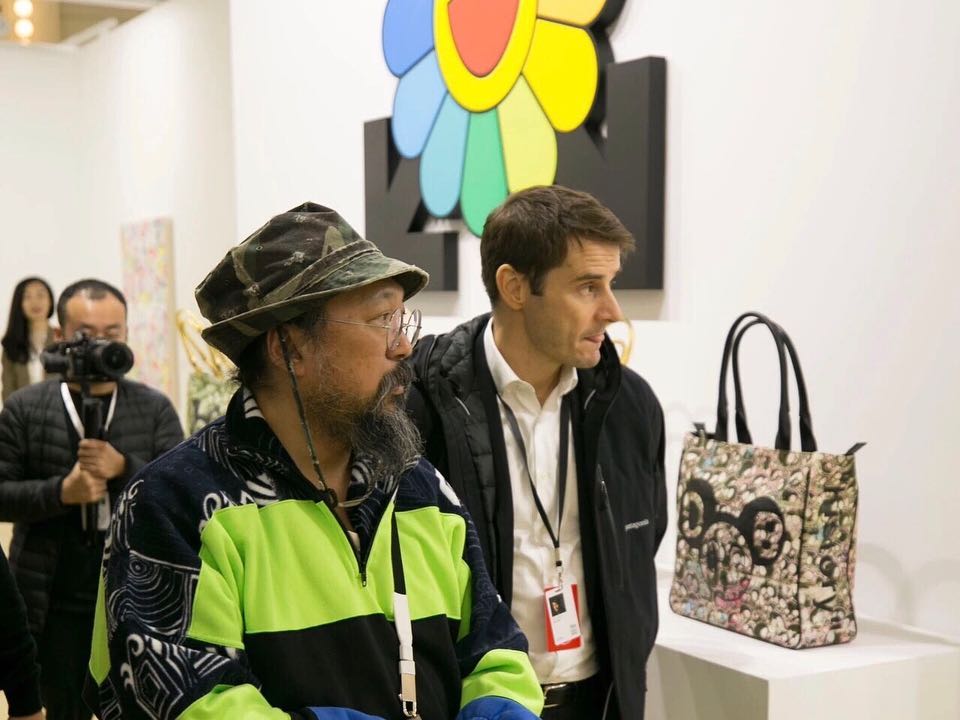
Takashi Murakami visiting booths at Art021 in Shanghai. Photo courtesy of Art021 via Instagram.
Chau says doubters originally warned that the fair’s timing in November would never work, due to the dominance of London and New York events including Frieze in October and November auctions. However, West Bund, which was originally held in September, soon switched to November, a move he suggests was done to follow Art021.
Chau worked hard this year, he says, to bring “the most cutting edge and the best galleries, not necessarily the most wealthy mega-galleries.” (Still, there was certainly a concentrated presence of major spaces, with a cluster including Zwirner, Hauser & Wirth, Gagosian, and Ropac all concentrated in one hall of the convention center.)
Art021 also invited Cesar Garcia, founder of the Los Angeles-based nonprofit the Mistake Room, to curate a special section called “Detour” that more than ticked the “cutting-edge” galleries box.
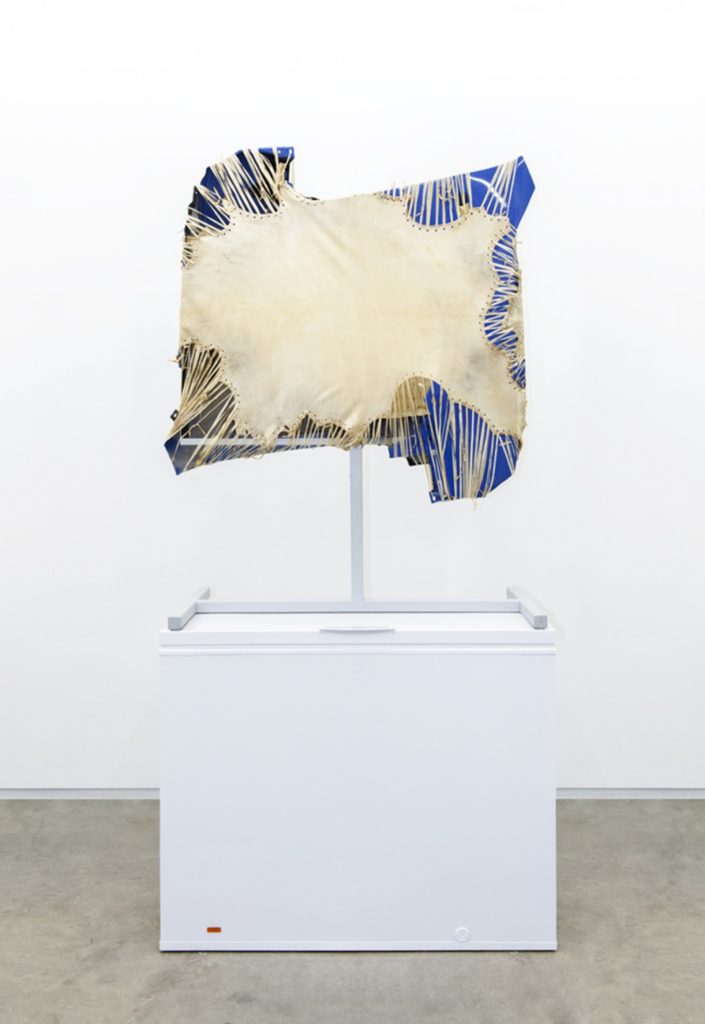
Brian Jungen’s Mother Tongue at Catriona Jeffries’ booth. Image courtesy of Catriona Jeffries.
Included in this section were Los Angeles-based Ghebaly Gallery, with works by Sayre Gomez and Shulamit Nazarian, and Vancouver’s Catriona Jeffries, showing works by Brian Jungen.
Jungen often uses everyday materials to create Native American-associated imagery, fusing consumerism with sacred symbols, such as a horse head made out of fused Nike Air Jordans where the shoelaces form a “mane.” (He is featured in the Crystal Bridges museum’s current show of work by Native Americans titled “Art for a New Understanding: Native Voices, 1950s to Now.”)
Also part of the Garcia-curated “Detour,” a “black box” video room that shows a loop of videos. One of these is by Oscar Murillo, whose Ramon follows a lottery ticket seller through the streets of the artist’s hometown in Colombia, as he attempts to unload tickets for sale.
Garcia explained that when he had accepted the project, it was originally with a focus on the Pacific Rim, and he had started examining a history that went back to the 16th century exchange of trade between Manila and Acapulco. “There was a lot of cultural exchange but also a much more contemporary position of interdependence within the region—one that’s based on immediacy and transactions that are usually, in theory, cross communications.”
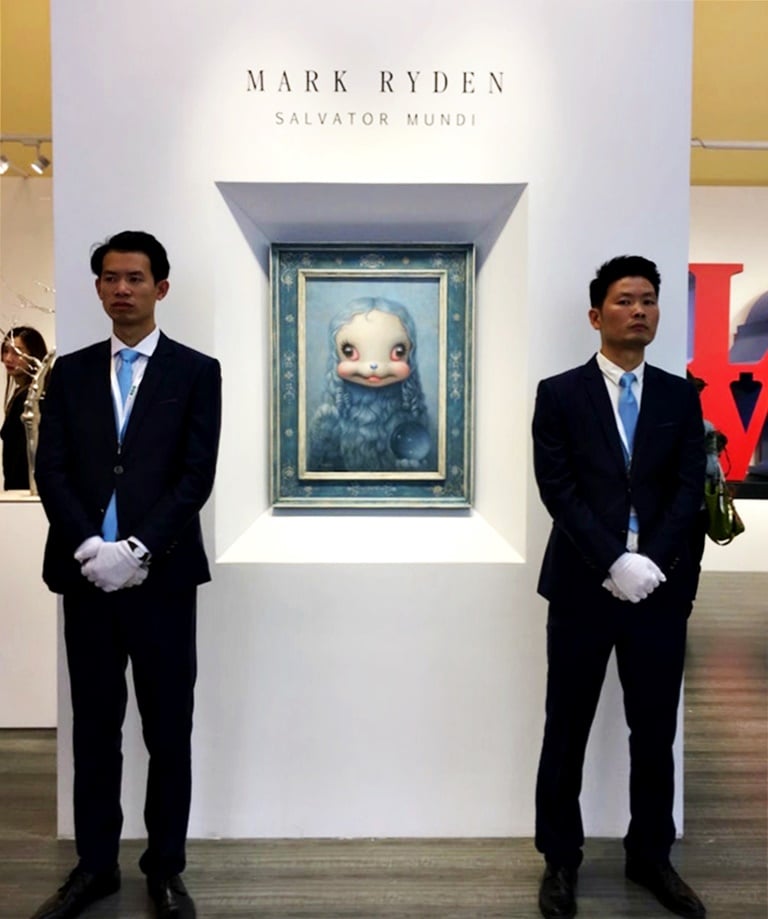
Mark Ryden, Salvator Mundi (2018) at Paul Kasmin’s booth at Art021 in Shanghai. Photo by Eileen Kinsella.
Meanwhile, in the main section of the fair, dealer Paul Kasmin was among the first-time exhibitors, with a booth that proved wildly popular. The gallery riffed on Christie’s viral marketing campaign for Leonardo da Vinci’s Salvator Mundi last fall, with a playful blue Mark Ryden portrait—sphere in hand and all—flanked by security guards in dark suits, at the front of the booth. By the end of the preview day, it had sold for about $350,000.
Other sales in the booth included James Nares’s Spark (2018) for $80,000, and Alex Katz’s OONA (2017), for $25,000.
Hauser & Wirth reported sales including Zhang Enli’s The Garden (2017), for $385,000 to a museum in China, as well as four works by Matthew Day Jackson, the highest of which was the artist’s mixed media Babel (2013), for $325,000 to a private collection in China. Four works by Rashid Johnson found buyers, the highest of which was Untitled Anxious Audience (2018), for $245,000 to a private collection in Indonesia. The gallery also sold two works by Takesada Matsutani, both priced at $150,000, including Germination 2014 (2014) and Cercle 08-9-10 (2008). Both went to private collections in Taiwan.
David Zwirner’s sales at Art021 included Oscar Murillo’s mixed media on canvas bank of (2017-18) for $300,000; Francis Alÿs’s diptych Untitled (2011-12), for $250,000; Carol Bove’s stainless steel and urethane paint S.O.S. (2018), for $220,000; two untitled works by Harold Ancart for $150,000 each; Wolfgang Tillmans’s Shenzhen still life (2018) for $95,000; two paintings by Lucas Arruda for $55,000 each; and Raymond Pettibon’s No Title (Teenage Love…) (1991), for $20,000.
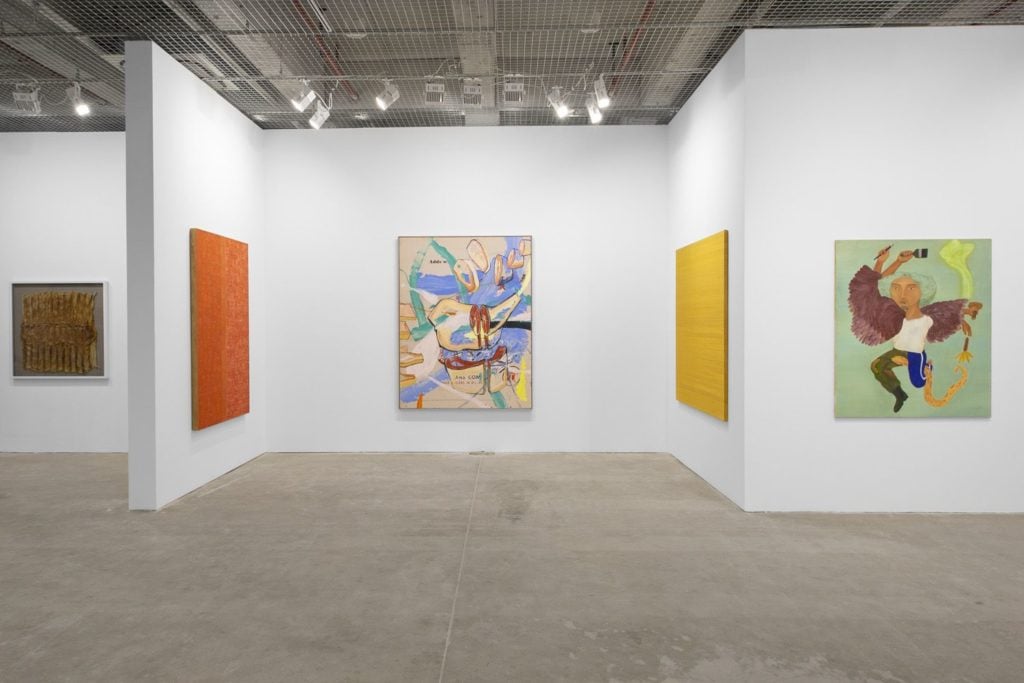
Installation view of Lehmann Maupin’s booth art West Bund Art + Design. Courtesy of Lehmann Maupin.
Meanwhile at West Bund, first time exhibitor Lehmann Maupin reported brisk sales. Gallery co-founder Rachel Lehmann was on hand to deliver a talk sharing highlights of her private collection and spoke about how assembling it has shaped her vision as a gallerist.
The gallery’s sales included McArthur Binion’s Ink: Work (Vermillion) (2018), for around $100,000; Angel Otero’s Someday Sunday (2018), for around $60,000; Hernan Bas’s Hide and Seek (Fuming) (2018), for about $150,000; and Suh Se Ok’s Two People (2000), for an undisclosed price.
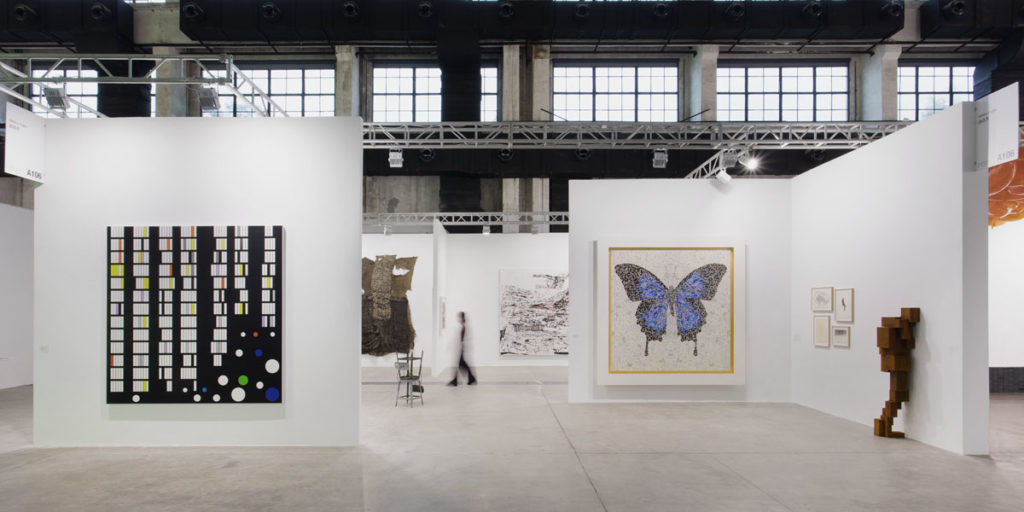
Installation view of White Cube Gallery at West Bund Art Fair. Courtesy of White Cube.
London’s White Cube gallery, exhibiting at West Bund for the fifth time, reported sales of work by George Baselitz, Tracey Emin, Antony Gormley, Mona Hatoum, and Chinese artists Liu Wei and Zhou Li.
Asked if broader economic volatility or concerns about the impact of tariffs on China are weighing on the mind of the art world, Jonas Stampe, senior curator and senior researcher at the Red Brick Art Museum in Beijing, was sanguine.
“I don’t think the trade war has had that much influence yet besides one of psychology which of course has its importance,” Stampe said. “Financially it has led to a weaker yuan, and the government raised taxes for its 1.5 billion population. What we see as a general trend on the art scene is that major collectors and entrepreneurs—and to a higher degree than before local governments—are constructing new huge structures to exhibit contemporary art.”
Stampe added that he thought it was true that there were “new groups of collectors, most of whom are quite young, who have entered the scene. They want to learn how the art system function. The question is, of course, what to buy and what to show. Basically who and what to trust. They surely don’t want to waste their money. You can call it a hesitation—although I would use the term cautiousness.”